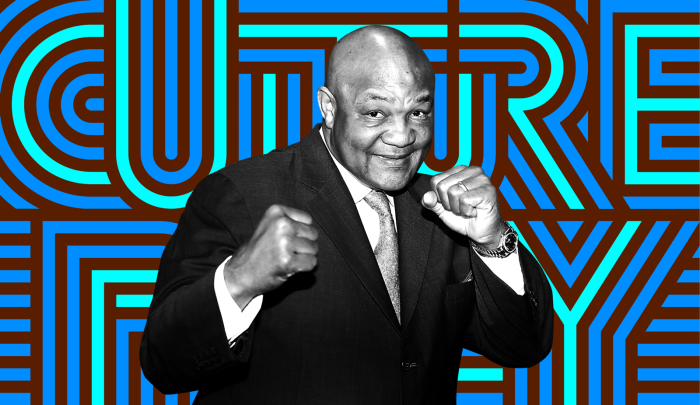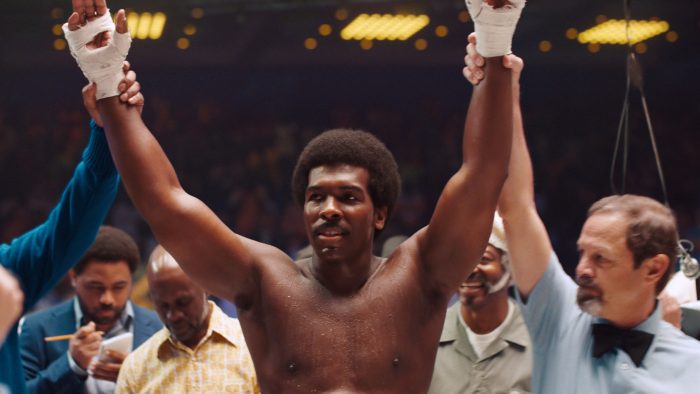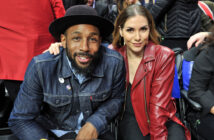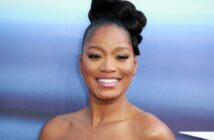Big George Foreman, in theaters now, begins by throwing viewers inside the eye of a tornado — a jam-packed stadium in 1974 in Kinshasa, Zaire, with thousands of people fixated on the boxing ring. In the center stood two giants of the sport: George Foreman and Muhammad Ali.
Directed by George Tillman Jr., Big George Foreman: The Miraculous Story of the Once and Future Heavyweight Champion of the World follows Foreman as he navigates a childhood full of struggle and solitude to eventually become one of boxing’s biggest stars. The subdued Foreman’s boxing career started out of necessity, but with his broad frame, the new fighter was a force of nature in bouts. Khris Davis, who plays Foreman in the film, knew he had to get into peak physical and mental shape to embody the boxing champ, especially if he wanted his portrayal to feel believable.
“I knew that I had to get to work because it’s such a big responsibility telling the story about Mr. Foreman,” Davis told Andscape. “You know, this guy fought Ali. This is the George Foreman Grill guy. I can’t mess this up.”
For Davis, getting to work meant hopping into boot camp and spending time with Foreman. “I don’t think I ever stopped trying to learn how to be sharper, how to punch harder and faster, or how to work on my feet,” he said. “There were many days where I’d go into the gym and nobody was in there and I’d just go into the ring to work on Mr. Foreman’s mannerisms. I would shadowbox. I would hit the heavy bag and the speed bag by myself. Sure, we could do six hours in the gym together, but was that really enough? I don’t think so.”
Sullivan Jones, who plays Ali in the film, also portrayed the legendary boxer in Kemp Powers’ 2013 play, One Night In Miami. “It’s a gargantuan honor and responsibility to play a global icon twice and that brought some trepidation and eagerness because you want to lean into the challenge and grow,” he said.
“Ten years ago, I had lunch with May May [Muhammad Ali’s daughter Maryum] and we talked about what it was like to be raised by him, his love for driving, what he would do if he wasn’t a boxer, and other information that I’d never seen in documentaries or read in books and that was indispensable,” Jones added.
‘The Rumble in the Jungle’ — and the poster that sold itRead now
In Big George Foreman, as the protagonist exhausts opportunities to earn money and gain confidence as a self-sufficient adult, Foreman meets Doc Broadus, a boxing coach played by Forest Whitaker, who sees major potential and takes him under his wing to learn how to train as a true boxer, kind of like how the real Foreman did with Davis.
“We did watch one of the fights between Ali and himself together,” Davis said. “He was explaining to me his fighting IQ and how smart of a fighter he was and how people often misunderstood that about him. I saw that to be true because when it came time to really dive in, me and my [off-screen] coach, Darrell Foster, would look at tapes every single day, and we were able to pinpoint just how smart of a fighter he was in the ring.”
The accuracy of Davis’ portrayal of Foreman made for competitive chemistry between his character and Jones’ Ali.
“I’m coming into it just from Mr. Foreman’s eyes,” Davis said. “So, Sullivan as Ali is a strong actor with a lot of strong energy. So, it was really good because both of us are the same in that way. We bring the heat. When Foreman and Ali are facing off, we’re able to stand in that heat together for viewers and won’t dilute the tension or truth for that moment. I think that that made for an impactful relationship between him and I.”
 George ForemanRead now
George ForemanRead now
Davis and Jones pushed their bodies to new levels to bring the larger-than-life athletes’ story to the screen. “Khris had to learn eight or nine different fights. I just had to learn ours. We were boxing four hours a day, five days a week for a month,” Jones said. “When you’re not boxing, you’re reviewing fight footage to capture some of the idiosyncrasies of your boxer. You’re lifting weights, you’re doing cardio, you’re doing nutrition. It is comprehensive.”
While Ali and Foreman didn’t have modern training regimens to help them prepare for their iconic 1974 fight — Jones said Ali would “chop trees and do other informal activities” — Davis and Jones hit the weights, boxing rings, and streets to get ready to play the legendary boxers.
“For a movie like Creed — Mike [Michael B. Jordan] and Jonathan Majors are so shredded and they have gym bodies that make total sense for a modern day-boxer,” Jones said. “But back then, these guys were walking around in bad shoes and most were smoking cigarettes and drinking. It was just a different time.”
Big George Foreman is a story of redemption, redirection, firmness in faith, and responsibility. Tillman captures the bravado of Ali and Foreman’s can-do personalities with authenticity, while also magnifying their humanity by emphasizing on their insecurities, toils with love, family, newfound fame and friendship.
Malik Peay is a seasoned Black journalist that uplifts other Black artists and leaders with his conversations on their multifaceted talents and the overall human experience. Through personal storytelling, he spotlights minority icons, their communities, and the individuals who thrive through their individual passions. Peay has been featured in Vanity Fair, Hollywood Reporter, Essence, W Magazine, Complex, Allure, Elle, Them, Teen Vogue, and more.


